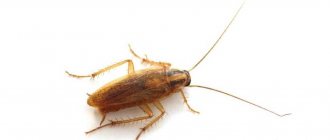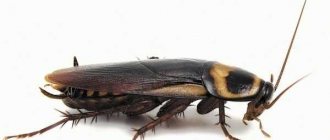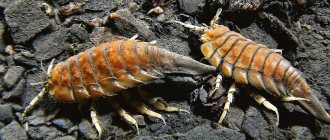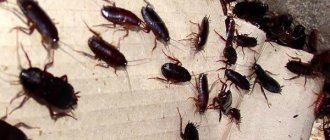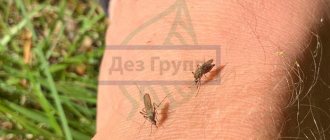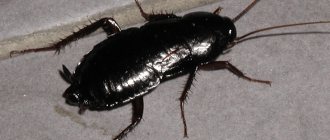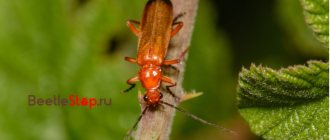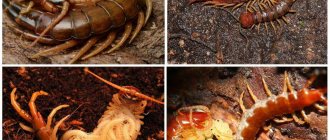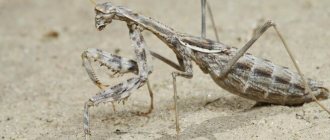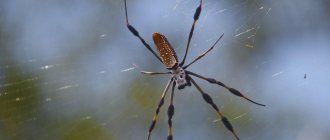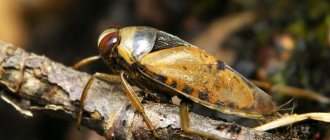- Wild animals
- >>
- Insects
The red cockroach is the bosom enemy of housewives, a nocturnal desecrator of kitchens and bathrooms. This is the insect of childhood, our unauthorized lodger, travel companion, hotel roommate and office cellmate. They have been trying to eradicate it for centuries, but it resists just as stubbornly, changing tastes and susceptibility to poisons. This is a universal soldier of nature, guarding its fundamental law - survival at any cost.
Origin of the species and description
Photo: Red cockroach
The red cockroach, also known as the Russian cockroach (Blattella germanica), belongs to the family Ectobiidae. It was described by Carl Linnaeus in his Systema Natura in 1767. The name of the genus comes from the Latin word “blatta,” which the Romans used to describe insects that are afraid of light.
Ectobiids, or tree cockroaches, are the largest cockroach family, containing about half of all cockroaches from the order Blattodea. But besides the Prussian, among them there will be no more than 5 similar pests occupying people’s houses. The most famous of them are black and American. The rest prefer a free life in nature.
Video: Red cockroach
In the structure of cockroaches, primitive features characteristic of ancient insects can be traced: chewing jaws, poorly developed flight muscles. The time of their appearance, judging by reliable prints, dates back to the beginning of the Carboniferous (about 320 million years ago). Phylogenetic analysis suggests that cockroaches originated earlier, at least in the Jurassic period.
Interesting fact: National antipathies are reflected in the popular names of the unpleasant insect. In Russia, this type of cockroach is called “Prusak”, since it was believed that it was brought from Prussia. And in Germany and the Czech Republic, which were once part of Prussia, they call him “Russian” for a similar reason. In fact, it is unknown where he appeared first. The routes of historical migrations of the red beast have not been studied.
Appearance and features
Photo: What a red cockroach looks like
Cockroaches are insects with an incomplete cycle of transformation and go through three stages as they develop: egg, larva (nymph) and adult (imago), and the larva differs little from the last stage. The larva hatches from the egg after 14 to 35 days and goes through 6 to 7 molts, each time increasing in size until it reaches the size of an adult cockroach. This process takes from 6 to 31 weeks. An adult male lives 100 - 150 days. The lifespan of a female is 190 - 200 days. The cockroach is dexterous, sneaky, elusive and disgusting, especially at the last stage.
Adult Prussians have a length of 12.7 - 15.88 cm and a weight of 0.1 to 0.12 g. The general color is light brown, two wide dark stripes run along the dorsal side of the prothorax. The chitinous lacquered cover is thin and the body is soft, which increases the aversion to this insect. The body shape is streamlined, oval, flattened and adapted to slip into any cracks.
The thoracic segments smoothly transform into a segmented abdomen, which is covered with paired soft wings. When frightened, the cockroach spreads its wings, but is only able to use them for gliding, for example, from a table to the floor. The spiky legs are long and strong - the legs of a real runner. The neat flattened head is decorated with flexible thin mustaches, which the Prussian warily moves around, trying to detect danger.
Males are slimmer and narrower than females; the narrowed end of the abdomen protrudes from under the wings and is equipped with two protruding setae - the cerci. In females, the end of the abdomen is rounded; they usually carry eggs in a special package - an ootheca. Larvae are nymphs that are smaller, but of the same shape. The color is darker, there is only one stripe and the wings are underdeveloped. The eggs are round and light brown.
Where does the red cockroach live?
Photo: Domestic red cockroach
South Asia is the recognized homeland of the Prussians. Their mass distribution begins in the 18th century - the era of world travel, scientific expeditions and colonial trade. Now red cockroaches have spread all over the world and inhabited all suitable habitats, not embarrassed by the presence of local relatives. They even managed to dislodge some, for example, the European black cockroach, from their established ecological niche.
By nature, the cockroach is an inhabitant of the tropics, a lover of warm climates and freezes when the temperature drops below −5 C°. Under natural conditions, it does not live outside a zone with a frost-free climate, in mountains above 2000 m, as well as in very dry regions, such as deserts. Only cold and drought prevent him from conquering the whole world, although, using the comfort of human dwellings, he is able to advance even to the Arctic.
Thanks to their universal tastes and undemanding food habits, Prussians inhabit any heated premises in cities and rural areas, both private and public. Especially if there is an abundance of food and moisture, like in kitchens and bathrooms. Prussians become a real disaster in hospitals and catering establishments. Urban housing with central heating and running water is ideal for them. Within the house they move through the ventilation system and garbage chutes, and to move to new places they often use suitcases or furniture.
Interesting fact: One of the effective ways to get rid of our intrusive little brothers is to freeze the premises. Therefore, cockroaches never settle in summer cottages.
Now you know that you can find a domestic red cockroach in your apartment. Let's take a look at what these insects eat.
For what reasons do they appear in a particular residential area?
There are several reasons:
- unsanitary conditions . Always dirty floors, unwashed dishes, cluttered corners, food residues lying around in different places (this could be spilled sugar or flour);
- things from trips . An insect can come to your home in a travel bag, having entered it from a hotel or train carriage;
- dysfunctional neighbors . It doesn’t matter which side the sluts are next to you (above, below, through the wall). Cockroaches will definitely get into your apartment from the ventilation hole or cracks in the walls and floor;
- faulty water and sewer pipes . Small damp places under the drop and warmth - this is a real cockroach paradise. As long as there is moisture nearby and the temperature in the apartment does not drop below 10 degrees, the Prussians will be ready to live with you forever.
What does the red cockroach eat?
Photo: Big red cockroach
Red pests eat any non-living matter containing organic matter. They even engage in cannibalism, eating their dead brothers. Garbage dumps and other places where human waste accumulates, farms, greenhouses, canteens, hospitals, nature museums and herbariums, library book depositories, archives and warehouses serve them as a table and a home.
They are especially attracted to:
- meat waste and carrion;
- products containing starch;
- anything that contains sugar;
- fatty food;
- paper, especially old books;
- natural fabrics, especially dirty ones;
- leather;
- soap and toothpaste;
- natural glue, such as bone glue, which was previously used in making books.
Cockroaches, like their closest relatives termites, owe their ability to digest cellulose to microorganisms that inhabit their intestines and, by digesting fiber, make it suitable for the host’s body.
Interesting fact: While developing a universal poison for the Prussians, scientists discovered that they had bred a race that does not eat sugar or anything that contains glucose. Experimental insects reacted to glucose as something unpleasant and bitter. This race is an evolutionary response to the poisoned sugar baits that have plagued all sweet tooth lovers. Only those cockroaches that neglected such a treat survived and multiplied.
Do they cause harm to humans?
IMPORTANT! Red cockroaches are dangerous to humans : constantly in contact with garbage, household waste, dirt, they are carriers of pathogenic bacteria, as well as worm eggs.
Intestinal disorders, tuberculosis, helminthiasis are just a few of the diseases that Prussians can bring on their paws.
Do red cockroaches bite?
Scientists knew of several cases when these pests ate away the keratinized parts of the dermis on the face and hands of people, but did not cause any tangible harm to them. So we can safely say that Prussians do not bite .
Features of character and lifestyle
Photo: Red cockroach, aka Prusak
Prussians belong to the so-called “synanthropic organisms”, which in life are closely connected with human society and live almost exclusively in the anthropogenic environment, in human dwellings. Their resettlement to new territories also occurs with the help of humans - cockroaches travel with our things and food in the holds of ships, on trains, vehicles and airplanes.
Having settled in the house, the adults and their growing nymphs go out at night to plunder. Although in the dark they are attracted to light surfaces, turning on the light causes the Prussians to instantly flee. This species itself does not make sounds, but the characteristic rustling of wings and legs that a fleeing flock makes is familiar to anyone who has had the misfortune of living in the same apartment with them.
Cockroaches act very harmoniously, since certain relationships are established between members of the cockroach community that has occupied one room. They use odorous substances called pheromones to signal the presence of shelter, food or danger, to transmit sexual signals. These pheromones are released in feces, and running insects leave here and there information trails along which their fellows gather for food, water, or find a partner for mating.
Interesting fact: Scientists conducted an experiment to find out where the pheromones that bring cockroaches together are produced and contained. A group of Prussians were poisoned by intestinal microorganisms and it turned out that their droppings no longer attracted other individuals. After feeding bacteria isolated from the feces of untreated cockroaches, their excretions became attractive again. It turned out that these bacteria are responsible for the synthesis of 12 fatty acids, which, evaporating in the air, serve as a signal for general collection.
Social structure and reproduction
Photo: Little red cockroaches
Prussians are sociable and, when living together, create a real democratic society of equals, who are united not only by common housing and growing nymphs, but also by common interests. The main one is food, and cockroaches master the food they find together, ingeniously informing their fellows about its location and even quantity using pheromones. The more cockroach tracks leading to a food source, the more attractive it is to others. They are also free to choose a sexual partner.
Cockroaches reproduce very actively. During her life, the female lays from 4 to 9 packages (ootheca) up to 8 mm long, each of which contains 30 to 48 eggs. The formation of the capsule and the maturation of the eggs in it takes an average of 28 days, and almost all this time the female wears it at the end of her abdomen. Although, in the end, it may dump the load in a dark, secluded corner.
After a few weeks, she develops new swelling. In total, each female produces up to 500 heirs. Reproduction in a flock occurs continuously and all generations and stages of development can be present in it at the same time. In a good place, the cockroach population grows like a snowball or, in mathematical terms, exponentially. Only cooling indoors or sanitary treatment can slow down growth.
Interesting fact: Nadezhda the cockroach became the first animal to conceive in space. This happened on September 14 - 26, 2007 on the unmanned biosatellite Foton-M 3. The cockroaches traveled in a container, and the fact of conception was recorded on video. Returning from the flight, Nadezhda gave birth to 33 cubs. The only unusual thing about them was that they grew faster than their earthly peers and acquired a dark color earlier. Nadezhda’s grandchildren did not show any peculiarities.
How to fight
You can destroy cockroaches in different ways. It depends on the number of insects and on the capabilities and preferences of humans.
As always, chemical and folk remedies help to poison the Prussians. The first of them are more effective and solve the problem faster. The latter are less dangerous to use, but require time, sometimes repeated use, to achieve results. The effect of each method may also be different.
Chemicals
These include insecticides (gels, traps, aerosols, powders, crayons), which are now widely represented in the assortment of hardware or specialty stores:
- Traps. These devices work on the principle of a mousetrap. Cockroach traps are small cardboard or plastic boxes with bait inside and slits for the insects to crawl inside. The bait has an odor attractive to cockroaches. Having penetrated this smell into the box, the cockroach sticks to the sticky inner surface of the trap and can no longer get out. As the “mustachioed neighbors” fill up, the box is thrown away. Disadvantages of the device: it is only suitable for small numbers of insects; a device filled with cockroaches does not look aesthetically pleasing, to put it mildly, and for greater effect you need to install many of these traps at once.
- Gel. (Global, Fas, Clean House, etc.). It is applied dotted or dotted around the perimeter of the room and in places where insects are particularly concentrated. The gels last for quite a long time (about a month on average), have no odor, and are safe for humans. Disadvantages - it is not always convenient to apply (the furniture must first be moved away from the walls; it is not always possible to reach the most secluded corners).
- Chalk "Mashenka". This has long been a well-known remedy for Prussians, and has never failed. No effort required for application, no odor, long lasting effect. In addition, chalk can retain its properties for a long time even if the packaging is opened. The product is very cheap, but very effective. Minus: it’s better to “draw” with chalk in less noticeable places.
- Aerosols (Combat, Dichlorvos, Clean House, etc.). The result after using them is noticeable almost immediately. These poisons affect the nervous system of insects, leading to organ paralysis and painful but quick death. Thanks to aerosols, you can destroy a large colony of cockroaches at once. Disadvantages: unsafe for human health; complete evacuation of all family members and animals is required during treatment and for several hours after it.
But no matter how strong the insecticides are, none of them has a lethal effect on well-protected cockroach eggs. Any chemical product requires reuse when a new generation of insects is born.
Natural enemies of the red cockroach
Photo: What a red cockroach looks like
The cockroach is not poisonous and, in principle, can be eaten by any animal that does not disdain insects. But human housing provides him with reliable shelter from birds and other free-living predators. Here he can only be threatened by other synanthropic couch potatoes and slaves.
Namely:
- spiders;
- centipedes;
- indoor birds;
- cats and dogs can catch them for fun.
The main enemy of the red-haired Prussian becomes anyone under whose roof this evil creature falls. Any “green” person will agree that the insect causes considerable harm. All he needs to do is see his kitchen table after their visit.
Why is the Prusak harmful?
- carries more than 40 pathogens of microbial and viral infections (including dysentery), which is especially important in hospitals;
- intermediate host of three species of helminths and protozoa;
- causes and provokes allergies, worsens asthma;
- creates a stink in the room due to pheromones;
- spoils food products;
- messes things up;
- affects the psyche and can even bite.
Pest control measures have been improved over the centuries. Isolating food waste and water, setting traps from which they cannot escape, freezing the premises, and finally, chemical warfare - all methods have been tried. Mechanical methods turn out to be ineffective, and chemical methods only lead to further improvement of the pest. Modern Prussians are not sensitive to pyrethroids, the classic insecticides, and are weakly susceptible to other older classes of pesticides. Modern drugs (hydroprene, methoprene) act as growth regulators and are more effective. They delay molting and prevent the development of the insect.
Interesting fact: Previously, tits and blue tits were kept in homes, especially rural ones, specifically to fight cockroaches. The birds spent the winter in a warm place, cleared the house of pests, and in the spring, according to tradition at Easter, they were released.
Insect feeding
Omnivorous cockroaches
Cockroaches are very voracious insects and have a variety of food preferences . They eat black bread, boiled potatoes, carrots, sugar beets, syrups, flour products, grains, leather, leather bindings, cotton wool, silk, wool, paper, glue, carcasses of animals and insects, feces, oil and other fats.
They chew solid food with powerful mouthparts and dissolve it with saliva. Cockroaches are not sensitive to the lack of food; adults can fast for 30-40 days , larvae for 9-22 days. But they are highly dependent on liquids and cannot live for long without drinking . This is important to consider when organizing pest control activities. Otherwise, the success of processing may be reduced to zero. You can read about other reasons for the reappearance of pests in the article “Why do they appear again after baiting cockroaches and bedbugs?”
